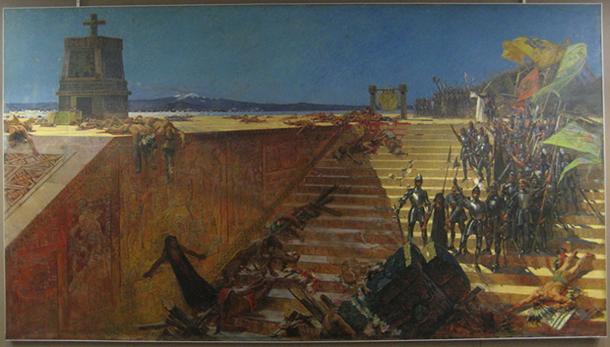The fall of Tenochtitlan is an important event in the history of the Americas as it marks the end of the Aztec Empire. This event took place on August 13, 1521 and was the result of a three-month long siege. However, it may be argued that the Spanish were not really the masters of Mexico upon completing this task, and they would only achieve this status some decades later.
Despite the Aztec Empire coming to an end, local resistance continued outside Tenochtitlan, which would take the Spanish about 60 grueling years to completely suppress. Hence, the fall of Tenochtitlan is often regarded as the end of the first phase of the Spanish conquest of Mexico .

Attack of the Spanish-Tlaxcallan forces with Malinche and Cortés. Depicted by the Spaniards’ Tlaxcallan native allies. 1773 Reproduction from 1584 original version of the Lienzo de Tlaxcala. ( Public Domain )
Hernán Cortés and Moctezuma II
The fall of Tenochtitlan took place about two years following Hernán Cortés’ arrival in Aztec territory. Cortés’ expedition had arrived in Mexico in the early part of 1519, and by the end of the same year the Spanish had laid their eyes on Tenochtitlan for the first time. When the conquistadors arrived in Tenochtitlan, it was one of the largest cities in the world. It has been estimated that during that period, only a handful of cities could match its size.
Cortés and his men were initially well-received by the Aztec ruler, Moctezuma II . It has often been said that the Aztecs treated the conquistadors well as a result of a prophecy. According to this prophecy, one their gods, Quetzalcoatl, would return to Mexico. The Spanish are said to have arrived at the right time and from the right direction for them to take advantage of this belief. Moreover, the prophecy is said to have described Quetzalcoatl as fair-skinned and bearded.

Tenochtitlan, Entrance of Hernan Cortes. Cortes and La Malinche meet Moctezuma II. November 8, 1519. ( Public Domain )
However, it has been argued that this story was a post-conquest invention, and that the Aztecs were aware that the Spanish were mortals, and not gods.
Fighting Back
In any event, when the Spanish first landed, Moctezuma is said to have sent gold to the Spanish as a gift. It has been suggested that the Aztec ruler was hoping that these gifts would appease these foreigners and make them leave. Instead, Cortés and his men were hungry for more, and decided to press on to Tenochtitlan. Moctezuma greeted the Spanish warmly and gave them more gold. In return, Cortés took Moctezuma as his prisoner and tried to rule the city in his place.
The Aztecs were not at all pleased with this, and wanted to expel the Spanish from their city. In April 1520, a rival conquistador arrived in Mexico, and Cortés left the city to deal with him. It was during Cortés’ absence that relations between the Spanish and the Aztecs deteriorated rapidly, culminating in an Aztec revolt . When news reached Cortés, he rushed back to Tenochtitlan, though it was to no avail, as the Spanish were successfully expelled by the Aztecs during the La Noche Triste (meaning ‘The Sad Night’).

17th Century painting of ‘La Noche Triste.’ ( Public Domain )
According to Cortés, 150 Spanish and 2000 native allies were killed during this retreat. The number of Spanish dead, according to other sources, is placed between 450 and 1150. The Spanish invaders, however, were not completely crushed, and, perhaps more importantly, Cortés escaped with his life.
Tenochtitlan Under Siege
Once in allied territory, Cortés began planning the recapture of Tenochtitlan. Among other things, Cortés needed more fighting men – this was accomplished by rebuilding his old alliances with the natives and finding new allies. At the same time, Tenochtitlan was struck by a smallpox epidemic, which decimated its population. Many Aztec warriors, nobles, and even Moctezuma’s successor , were killed by this disease. Cortés also realized that one of his previous weaknesses was a lack of mobility on the lake – in order to counter this, he began building ships.
In May 1521, Cortés began his siege of Tenochtitlan. The Spanish plan was to cut off the city’s supplies by disconnecting it from the mainland, thus forcing its inhabitants to submit. As the Spanish drew ever closer to Tenochtitlan, the Aztecs attempted to break their grip, though these efforts were not successful. The Spanish eventually reached the city, though more fighting had to be done before the Aztecs finally surrendered on August 13, 1521.

“The Last Days of Tenochtitlan—Conquest of Mexico by Cortez” — 1899 painting by William de Leftwich Dodge. ( Public Domain )
As a result of the fall of Tenochtitlan, Aztec dominance in Mexico came to an end and the Spanish were the new rulers of the area, though it would take them another couple of decades to consolidate their position .
Top image: A 17th century painting known as “Conquista de México por Cortés” (The Conquest of Mexico by Cortés). Source: Public Domain
By Wu Mingren
Updated on December 4, 2020.
Related posts:
Views: 0
 RSS Feed
RSS Feed

















 December 5th, 2020
December 5th, 2020  Awake Goy
Awake Goy  Posted in
Posted in  Tags:
Tags: 
















